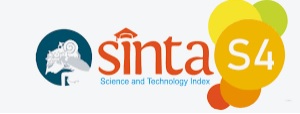Kajian Pengembangan Enterprise Architecture Pada Industri Software House
Abstract
The presence of a local software house company is a solution choice for companies on a small, medium and large scale. The software house company has been able to provide solutions to fulfill information systems and produce good quality software products. However, local software house companies face operational problems with the company's internal information technology in completing projects obtained from their customers. To solve the company's internal information technology problems, the company applies the enterprise architecture method to streamline the company's operations. So far, information technology operations in software house companies have experienced ineffective operations with various application systems that have been implemented. Changes in information technology operations by rearranging using the Enterprise Architecture method, and applying it to the company's software house. This study aims to develop Enterprise Architecture in a software house company, where all are designed using Information Technology Planning based on the TOGAF-based Enterprise Architecture Framework. With the application of Enterprise Architecture, information technology operations can be changed to be more organized and more efficient in supporting company operations.
Keyword: Software House; Enterprise Architecture; TOGAF; Information System
Â
Abstrak. Hadirnya perusahaan software house lokal menjadi pilihan solusi bagi perusahaan dalam skala kecil, skala medium dan skala besar. Perusahaan software house telah mampu memberikan solusi pemenuhan sistem informasi dan menghasilkan produk software yang berkualitas baik. Namun perusahaan software house lokal menghadapi permasalahan operasional informasi teknologi internal perusahaan dalam menyelesaikan proyek yang didapat dari pelanggannya. Untuk menyelesaikan permasalahan informasi teknologi internal perusahaan, perusahaan menerapkan metode enterprise arsitektur dalam mengefektifkan operasionalnya. Selama ini operasional teknologi informasi di perusahaan software house mengalami operasional yang tidak efektif dengan berbagai sistem aplikasi yang telah diterapkan. Perubahan operasional teknologi informasi dengan menata ulang menggunakan metode Enterprise Architecture, dan menerapkannya ke dalam perusahaan software house. Penelitian ini bertujuan untuk mengembangkan Enterprise Architecture pada perusahaan software house, dimana semua dirancang dengan menggunakan Information Technology Planning dengan Framework Enterprise Architeture berbasis TOGAF. Dengan penerapan Enterprise Architecture dapat mengubah operasional informasi teknologi menjadi lebih tertata dan lebih efisien dalam mendukung operasional perusahaan.
Kata kunci: Software House; Enterprise Architecture; TOGAF; Sistem Informasi
References
V. V. Martynov, D. N. Shavaleeva, and A. I. Salimova, “Designing Optimal Enterprise Architecture for Digital Industry: State and Prospects,†Proc. - 2018 Glob. Smart Ind. Conf. GloSIC 2018, pp. 1–7, 2018, doi: 10.1109/GloSIC.2018.8570159.
K. Jamróz, D. Pitulej, and J. Werewka, “Adapting enterprise architecture at a software development company and the resultant benefits,†Lect. Notes Comput. Sci. (including Subser. Lect. Notes Artif. Intell. Lect. Notes Bioinformatics), vol. 8627 LNCS, pp. 170–185, 2014, doi: 10.1007/978-3-319-09970-5_16.
S. Hacks, H. Hofert, J. Salentin, Y. C. Yeong, and H. Lichter, “Towards the definition of enterprise architecture debts,†Proc. - IEEE Int. Enterp. Distrib. Object Comput. Work. EDOCW, vol. 2019-October, pp. 9–16, 2019, doi: 10.1109/EDOCW.2019.00016.
G. Shanks, M. Gloet, I. Asadi Someh, K. Frampton, and T. Tamm, “Achieving benefits with enterprise architecture,†J. Strateg. Inf. Syst., vol. 27, no. 2, pp. 139-156, 2018, doi: 10.1016/j.jsis.2018.03.001.
Y. Gong, J. Yang, and X. Shi, “Towards a comprehensive understanding of digital transformation in government: Analysis of flexibility and enterprise architecture,†Gov. Inf. Q., vol. 37, no. 3, p. 101487, 2020, doi: 10.1016/j.giq.2020.101487.
J. J. Korhonen and M. Halen, “Enterprise architecture for digital transformation,†in Proceedings - 2017 IEEE 19th Conference on Business Informatics, CBI 2017, pp. 349-358, 2017, vol. 1, doi: 10.1109/CBI.2017.45.
E. Niemi and S. Pekkola, “The Benefits of Enterprise Architecture in Organizational Transformation,†Bus. Inf. Syst. Eng., vol. 62, no. 6, pp. 585-597, 2020, doi: 10.1007/s12599-019-00605-3.
Z. Pourzolfaghar, V. Bastidas, and M. Helfert, “Standardisation of enterprise architecture development for smart cities,†J. Knowl. Econ., vol. 11, no. 4, pp. 1336-1357, 2020, doi: 10.1007/s13132-019-00601-8.
T. P. Sales, B. Roelens, G. Poels, G. Guizzardi, N. Guarino, and J. Mylopoulos, “A Pattern Language for Value Modeling in ArchiMate,†in Lecture Notes in Computer Science (including subseries Lecture Notes in Artificial Intelligence and Lecture Notes in Bioinformatics), vol. 11483, pp. 230-245, 2019, doi: 10.1007/978-3-030-21290-2_15.
A. Ellerm and M. E. Morales-Trujillo, “Modelling Security Aspects with ArchiMate: A Systematic Mapping Study,†IEEE, pp. 577-584, 2020, doi: 10.1109/SEAA51224.2020. 00094.
S. de Kinderen, K. Gaaloul, and H. A. Proper, “Bridging value modelling to ArchiMate via transaction modelling,†Softw. Syst. Model., vol. 13, no. 3, pp. 1043-1057, 2014, doi: 10.1007/s10270-012-0299-z.
A. Sadovykh, A. Bagnato, A. J. Berre, and S. Walderhaug, “ArchiMate as a Specification Language for Big Data Applications - DataBio Example,†in Lecture Notes in Computer Science (including subseries Lecture Notes in Artificial Intelligence and Lecture Notes in Bioinformatics), Springer, vol. 12055, pp. 191-199, 2020 doi: 10.1007/978-3-030-39306-9_14.
M. Varl, J. Duhovnik, and J. TavÄar, “Customized product development supported by integrated information,†J. Ind. Inf. Integr., no. 25, p. 100248, 2021, doi: 10.1016/ j.jii.2021.100248.
A. E. Coronado Mondragon and C. E. Coronado Mondragon, “Managing complex, modular products: how technological uncertainty affects the role of systems integrators in the automotive supply chain,†Int. J. Prod. Res., vol. 56, no. 20, pp. 6628-6643, 2018, doi: 10.1080/00207543.2018.1424362.
E. K. Szczepaniuk, H. Szczepaniuk, T. Rokicki, and B. Klepacki, “Information security assessment in public administration,†Comput. Secur., vol. 90, pp. 101709, 2020, doi: 10.1016/j.cose.2019.101709.
S. R. Mirsalari and M. Ranjbarfard, “A model for evaluation of enterprise architecture quality,†Eval. Program Plann., vol. 83, p. 101853, 2020, doi: 10.1016/j.evalprogplan. 2020.101853.
A. Q. Ali, A. B. M. Sultan, A. A. A. Ghani, and H. Zulzalil, “A Systematic Mapping Study on the Customization Solutions of Software as a Service Applications,†IEEE, vol. 7, pp. 88196-88217, 2019, doi: 10.1109/ACCESS.2019.2925499.
R. Gao, Y. Wang, Y. Feng, Z. Chen, and W. Eric Wong, “Successes, challenges, and rethinking – an industrial investigation on crowdsourced mobile application testing,†Empir. Softw. Eng., vol. 24, no. 2, pp. 537-561, 2019, doi: 10.1007/s10664-018-9618-5.
B. Hanafi and R.D.H. Purba, "Perancangan Enterprise Architecture Dengan Modified Togaf Adm Pada PT Ilmu Komputercom Braindevs Sistema. Journal of Information System, Informatics and Computing, vol. 5, no. 2, pp. 222-231, 2021.
How To Cite This :
Refbacks
- There are currently no refbacks.











